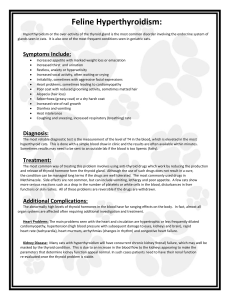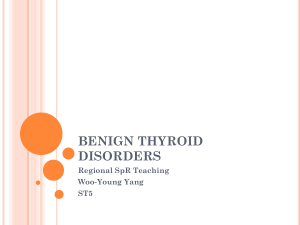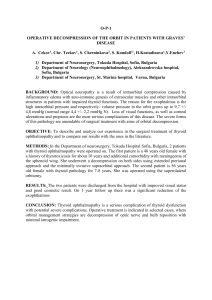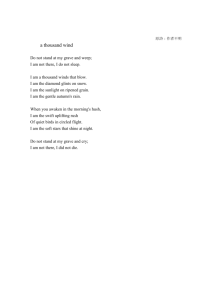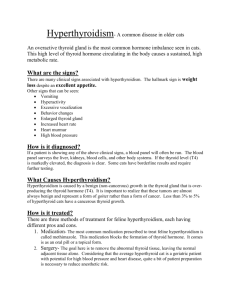Goitre - Jansen
advertisement
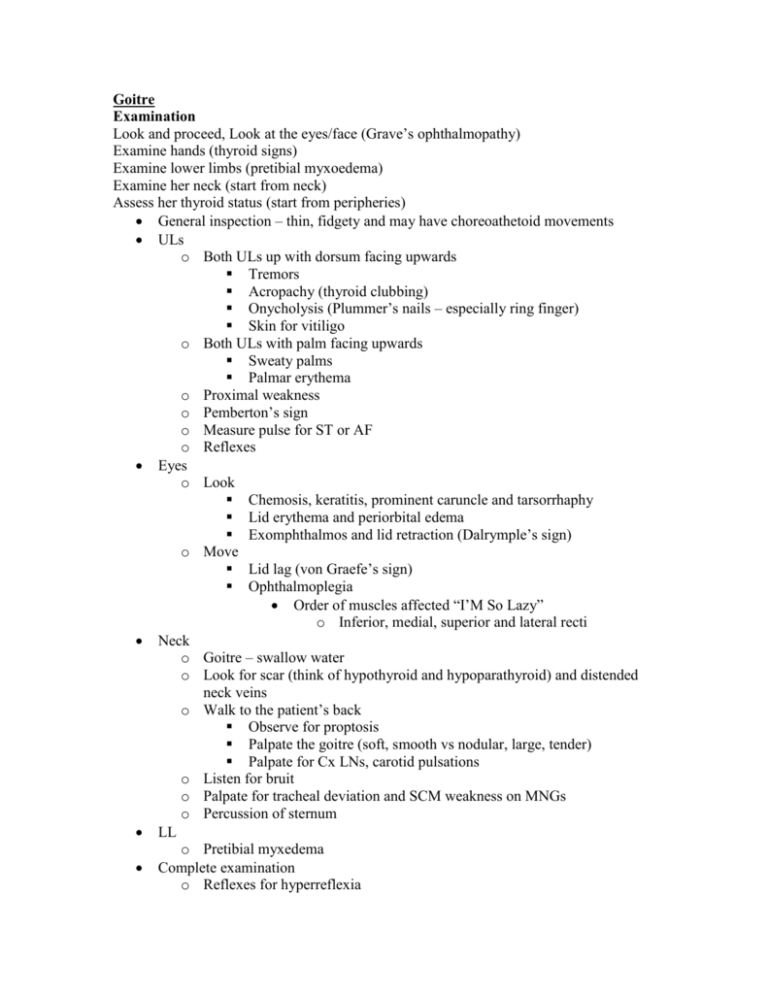
Goitre Examination Look and proceed, Look at the eyes/face (Grave’s ophthalmopathy) Examine hands (thyroid signs) Examine lower limbs (pretibial myxoedema) Examine her neck (start from neck) Assess her thyroid status (start from peripheries) General inspection – thin, fidgety and may have choreoathetoid movements ULs o Both ULs up with dorsum facing upwards Tremors Acropachy (thyroid clubbing) Onycholysis (Plummer’s nails – especially ring finger) Skin for vitiligo o Both ULs with palm facing upwards Sweaty palms Palmar erythema o Proximal weakness o Pemberton’s sign o Measure pulse for ST or AF o Reflexes Eyes o Look Chemosis, keratitis, prominent caruncle and tarsorrhaphy Lid erythema and periorbital edema Exomphthalmos and lid retraction (Dalrymple’s sign) o Move Lid lag (von Graefe’s sign) Ophthalmoplegia Order of muscles affected “I’M So Lazy” o Inferior, medial, superior and lateral recti Neck o Goitre – swallow water o Look for scar (think of hypothyroid and hypoparathyroid) and distended neck veins o Walk to the patient’s back Observe for proptosis Palpate the goitre (soft, smooth vs nodular, large, tender) Palpate for Cx LNs, carotid pulsations o Listen for bruit o Palpate for tracheal deviation and SCM weakness on MNGs o Percussion of sternum LL o Pretibial myxedema Complete examination o Reflexes for hyperreflexia o Cardiovascular examination Wide pulse pressure (if clinically hyperthyroid) and systolic hypertension ESM,CCF Gynaecomastia o If there is a scar, request to perform Trousseau’s sign and Chvostek’s sign for hypoparathyroidism, assessment for hoarseness of voice o Abdominal examination may reveal hepatosplenomegaly in Grave’s disease Presentation Grave’s disease Sir, this patient has got Grave’s disease and is clinically hyperthyroid complicated by Grave’s ophthalmopathy. There is presence of a diffusely enlarged, smooth and firm goitre which is associated with a bruit and is non-tender. There are no palpable LNs and tracheal is central with no dullness to percussion of the sternum. Pemberton’s sign is negative. There is evidence of hyperthyroidism. Patient is thin looking and is anxious and fidgety with presence of fine tremors of the outstretched hands, sweaty palms, with palmar erythema and a resting sinus tachycardia. I did not notice any thyroid acropachy or onycholysis. There is also no evidence of proximal upper limb weakness. Examination of the eyes reveals presence of lid retraction with a staring appearance. There is no chemosis, keratitis or evidence of tarsorraphy. There is evidence of exomphthalmos and proptosis. There is no ophthalmoplegia. There is no evidence of pretibial myxedema. Multinodular Goitre Sir, this patient has MNG and is hyperthyroid complicated by atrial fibrillation. There is presence of an enlarged goitre with multiple nodules bilaterally with a dominant nodule in the right lobe of the thyroid gland. This is non tender. There is no associated Cx LN and the carotid artery is palpable. There are no signs of compression such as stridor, negative Pemberton’s sign with no dullness to percussion of the sternum. There are signs of hyperthyroidism. The patient is in atrial fibrillation; did not notice any easy brusibility or obvious hemiplegia Questions What is Grave’s disease? Autoimmune disease TSI binds to and stimulates the TSH receptor on the thyroid cell membrane Resulting in excessive synthesis and secretion of thyroid hormone 2% in women and 0,2% in men; 2nd to 4th decades What are the clinical signs specific to Grave’s disease? Grave’s ophthalmopathy Pretibial myxedema Thyroid acropachy Diffuse goitre Lymphoid hyperplasia What is Grave’s Ophthalmopathy? Characterised by edema and inflammation of the extraocular muscles increase in orbital connective tissue and fat edema is due to hydrophilic action of the glycosaminoglycans secreted by fibroblast inflammation is due to infiltration by lymphocytes and macrophages Worst in Smokers, elderly males Post radio-iodine treatment Severe hyperthyroidism Can occur pre, during or post diagnosis of hyperthyroidism How do you assess activity of the eye disease? Retrobulbar pain Pain on eye movement Eyelid erythema Conjunctival injection Chemosis Swelling of the caruncle Eyelid edema Points system together with degree of proptosis (Hertel’s ophthalmometer), reduced VA and eye movements What is pretibial myxedema? Specific feature of Grave’s disease Types o Lymphedema type Symmetrical, well defined, waxy and shiny peau d’orange appearance Red but not inflamed, swollen but not edematous o Nodular type o Plague type Occurs on the shins, anterior lateral aspects Can also occur as localised dermopathy at sites of trauma Characterise by edema, accumulation of glycosaminoglycans and lymphocytic infiltrates Usually after treatment of hyperthyroidism, especially after radioactive iodine What are the signs of hyperthyroidism? Resting tachycardia (important) Sweaty palms Tremors Hyperreflexia Thyroid bruit What are the causes of hyperthyroidism? Primary Grave’s disease Toxic MNG (Plummer’s disease) Toxic adenoma De Quervain’s thyroiditis Post partum thyroiditis (Characteristics: Reduced radionuclide uptake, low T3/T4 ratio and raised Thyroglobulin level) Secondary Pituitary Struma ovarii, hydatidiform mole or choriocarcinoma (ectopic TSH) Exogenous Overtreatment (eg in thyroid cancer) Factitious Drug induced – Lithium, amiodarone (type 1 i.e. iodine induced and type 2 i.e. inflammatory thyroiditis) What are the differential diagnoses of swellings in the neck? Midline o Thyroid gland which rises on swallowing o Thryroglossal cysts which also rises on swallowing but also moves on sticking out the tongue o Submental LNs Lateral o LNs o Salivary Glands o Skin – sebaceous cysts or lipoma o Cystic hygroma o Pharyngeal pouch How would you grade the goitre? WHO grading: Grade 0 : not palpable or visible Grade 1A: palpable goitre Grade 1B : palpable and visible only on neck extension Grade 2: Visible goitre at primary position Grade 3: Obvious goitre from a distance What is Pemberton’s sign? Elicited by asking the patient to lift his arms above her head Development of plethora, cyanosis, inspiratory stridor and respiratory distress and distension of neck veins Test for thoracic inlet obstruction due to a retrosternal mass How do you differentiate between thyroid acropachy and HPOA? Radiographically o Thyroid acropachy new bone formation has a soap bubbles appearance on the bone surface with coarse spicules o HPOA new bone formation in a linear distribution What are the associated clinical conditions with Grave’s disease? Diabetes mellitus Vitiligo Pernicious anaemia Addison’s disease Myasthenia gravis Alopecia areata How would you investigate this patient with Grave’s disease? Confirm the diagnosis o Thyroid stimulating hormone levels (aka thyrotropin levels) o Free thyroxine levels; KIV serum free tri-iodothyronine o Autoantibodies such as TSH receptor Ab(TRAb), thyroid peroxidase antibodies and thyroglobulin antibodies o Occasionally, to differentiate between Graves and autoimmune thyroiditis, radionuclide scan which shows diffuse uptake in Graves and no/low uptake in autoimmune thyroiditis Ophthalmopathy o CT or MRI orbits to rule out retrobulbar tumor or AVM especially in unilateral exomphthalmos How would you investigate this patient with MNG? Activity assessment – fT4 and TSH Imaging – CT neck to look for obstruction Radionuclide in a predominantly “hot nodule” What is T3 thyrotoxicosis? Hyperthyroid symptoms and sign normal fT4 (thyroxine) level elevated T3 (triiodothyronine). What is “sick euthyroid”? Occurs in patient’s with severe illness or physical trauma Alterations of peripheral transport and metabolism of thyroid hormones Low fT4 and T3 and inappropriately low TSH How would you manage this patient? (1) Grave’s disease: Medical therapy o Symptomatic treatment with propranolol o Carbimazole, methimazole and propylthiouracil o All inhibit thyroid peroxidase and hence thyroid hormone synthesis o PTU also inhibit conversion of fT4 to fT3, useful in crisis o CMZ and MTZ useful as fewer tablets and once daily dosing o Treated for 12-18 months and 30-40% will remain euthyroid o If it recurs, likelihood of remission on medications is low o Minor adverse effects (5%) fever, rash, urticaria and arthralgia o Major adverse effects (0.5%) (CMZ and MTZ are dose related and PTU is not) agranulocytosis Advised to stop the drug if develop fever, sorethroat or mouth ulcers Severe hepatotoxicity Vasculitis Lupus-like syndrome Radio-iodine (131-I at dose 5 to 15 mCi) o 90% will become euthyroid within 2 months. o Contraindicated in pregnant and breast-feeding mothers, children and adolescent o Side effects Almost all will become hypothyroid Neck pain Worsened thyrotoxicosis for several days post treatment Prevented with CMZ/MTZ pre-treatment for 1-2 months and stopped 3-5 days before treatment; try not to use PTU as this decrease efficacy of I -131 treatment Observed if mild or treat with beta blockers Should not give antithyroid medications unless severe or expected to be severe due to poor control at the time of I131 administration Worsening of ophthalmopathy especially in smokers and severe hyperthyroidism Administration of glucocorticoids can prevent worsening Thyroidectomy o Indications includes “Cs”: Cancer (dominant nodule), cosmesis, compression o o o o Effective in 90% Not a/w worsening of Grave’s ophthalmopathy Side effects : recurrent laryngeal nerve, hypoparathyroidism (1-2%) Medications given prior to surgery and Lugol’s iodine given 7-10 days prior to surgery (2) MNG Render euthyroid with thionamide As spontaneous remission does not occur, ablative therapy required No obstruction – Radio-iodine Obstruction – Surgical (3) Toxic Adenoma Render euthyroid with thionamide Radio-iodine – hypothyroidism side effect is less compared to Grave’s disease as the toxic adenoma suppresses the other thyroidal tissue Surgical – Lobectomy (4) Subacute thyroiditis Should not Rx with thionamides Rx with propranolol, aspirin, NSAIDs and glucocorticoids How would you counsel a young woman with thyrotoxicosis who wishes to be pregnant? Ideally, pregnancy should be avoided until hyperthyroidism is adequately treated because the rate of fetal loss is high If it occurs or recurs during pregnancy, then o Treat with PTU Lowest dose possible such that fT4 is at the upper range of normal Combination therapy contraindicated because PTU passes the placenta but thyroxine doesn’t, resulting in fetal hypothyroidism PTU better because of better binding to proteins and therefore less transplacental transfer theoretically; also CMZ a/w rare side effects of aplasia cutis congenita, esophageal and choanal atresias o Can also be safely treated with surgery in the second trimester with almost no risk of death in experienced hands o In the 3rd trimester, TSI levels declines and remission of hyperthyroidism occurs; stopping medications is possible then o 1-5% of fetuses may be hyperthyroid resulting in IUGR and tachycardia o up to 750mg/d PTU or 20mg CMZ can be safely used in lactating mothers How do you treat Graves ophthalmopathy? General measures o Maintenance of euthyroidism o Stop smoking o Sleep with head raised o Use of artificial tears o Diuretics o Tinted glasses Specific measures (for severe disease) o Glucocorticoids – 40-80mg OM then taper over 3 months o Radiotherapy o Surgical decompression Stable disease o Surgery for lid retraction, exomphthalmos or diplopia
